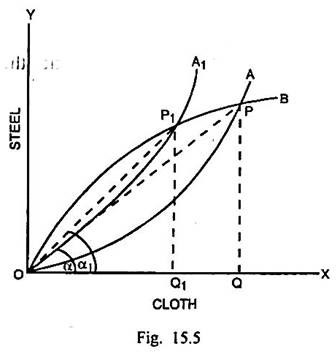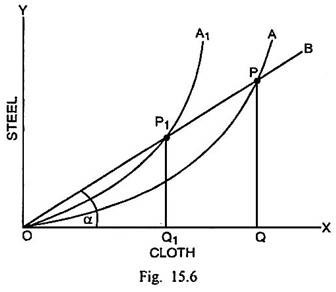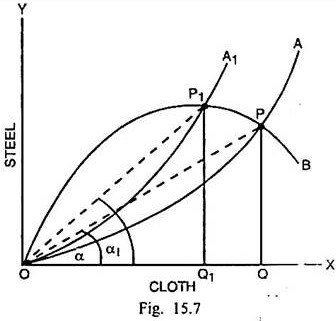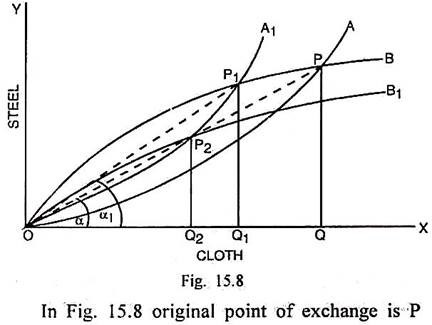In this article we will discuss about the effects of tariffs on terms of trade.
In the case of a large tariff-imposing country, the tariff is likely to improve the terms of trade for it. But the extent to which tariff can ensure the improvement in terms of trade is determined by the reciprocal demand of the two trading countries or their respective offer curves.
The most crucial factor, however, is the reactions of the foreign countries to the tariff moves of the home country. In other words, whether the terms of trade will become favourable or not for the tariff-imposing home country, depends upon whether the other countries retaliate or not to tariff restrictions imposed by the home country against their products.
Terms of Trade Effect in the Absence of Retaliation:
If a country resorts to the imposition of tariff while the foreign country does not retaliate, two types of effects can follow. Firstly, there is an improvement in the terms of trade of the tariff- imposing country. Secondly, the tariffs result in the contraction in the volume of trade. These effects of tariff can be shown through Fig. 15.5.
In Fig. 15.5 the commodity cloth which is exportable of home country A and importable of foreign country B is measured along the horizontal scale. The commodity steel which is exportable of B and importable of A is measured along the vertical scale. OA is the offer curve of country A and OB is the offer curve of country B. Initially, the exchange takes place at P where country A exports OQ quantity of cloth and imports PQ quantity of steel.
The terms of trade for the home country A at P = (QM/QX) = (PQ/OQ) = Slope of Line OP = Tan α. If the home country imposes tariff on steel, its offer curve shifts to the left, which indicates that the steel has become relatively more costly than cloth. Now exchange takes place at P1 where the given offer curve of country B intersects the offer curve OA1 of country A.
At this point, country A imports P1Q1 quantity of steel and exports OQ1 quantity of cloth. The terms of trade for country A at P1 = (QM/QX) = (P1Q1/OQ1) = Slope of Line OP1 = Tan α1. Since Tan α1 > Tan α, there is an improvement in the terms of trade for the tariff-imposing home country A, subsequent upon the imposition of tariff.
Prior to the imposition of tariff, the volume of trade was constituted by OQ exports of cloth plus PQ imports of steel. After the imposition of tariff both exports and imports stand reduced to OQ1 and P1Q1 respectively. Thus there is a fall in the volume of trade after tariff is imposed.
ADVERTISEMENTS:
The above analysis concerning the effect of tariff upon terms of trade presumed an absence of retaliation by the foreign country and a less than perfectly elastic offer curve of the foreign country. If it is supposed that the offer curve of the foreign country is perfectly elastic, the tariff imposed by the home country will fail to bring about improvement in the terms of trade. Only effect tariff will have in such a situation is the reduction in the volume of international trade. It may be shown through Fig. 15.6.
In Fig. 15.6, OA is the offer curve of home country A and OB is the perfectly elastic offer curve of foreign country B. Originally the exchange takes place at P where A exports OQ of cloth and imports PQ quantity of steel. The terms of trade P = (QM/QX) = (PQ/OQ) = Slope of Line OP = Tan α. After tariff is imposed by country A. its offer curve shifts to OA1 but the offer curve of non-retaliating foreign country remains unaffected. The exchange takes place at P1 where OQ1 quantity of cloth is exported in return of P1Q1 quantity of cloth.
The terms of trade at P1 = (QM/QX) = (P1Q1/OQ1) = Slope of Line OP1 = Tan α. Since the terms of trade at both P1 and P are measured by the constant Tan α, it means there is no improvement in the terms of trade for the tariff-imposing home country A.
ADVERTISEMENTS:
The effect of tariff is only in the form of reduction in quantities exported and imported of the two commodities to OQ1 and P1Q1 respective. So the tariff leads to a contraction in the volume of trade without effecting improvement in the terms of trade.
In case the offer curve of the foreign country is highly inelastic, tariff can cause improvement in the terms of trade for the home country. No doubt, imports may get enlarged but the contraction in exports being relatively greater, there is still a net reduction in the volume of international trade. This case may be depicted through Fig. 15.7.
In Fig. 15.7 the offer curve OB of the foreign country B is highly inelastic. Initially the exchange takes place at P where country A exports OQ quantity of cloth and imports PQ quantity of steel. The terms of trade in this pre-tariff situation P are measured by (QM/QX) = (PQ/OQ) = Slope of Line OP = Tan α.
After the imposition of tariff by the home country A, its offer curve shifts to OA1 and the exchange takes place at P1. Country A exports OQ1 quantity of cloth in exchange of P1Q1 quantity of importable commodity steel. The terms of trade at P1 = (QM/QX) = (P1Q1/OQ1) = Slope of Line OP1 = Tan α1.
Since Tan α1 > Tan α, it signifies that there is an improvement in terms of trade even in this situation. Although the quantity imported increases after tariff from PQ to P1Q1, yet the decline in export QQ1 is relatively greater. Therefore, the volume of trade contracts even in this situation.
Terms of Trade Effect in the Event of Foreign Retaliation:
The possibility of improvement in the terms of trade can exist under the assumption that the foreign country does not retaliate to the imposition of tariff by the home country on foreign products. Such an assumption is clearly unrealistic. In fact, tariff restrictions imposed by the home country provoke the foreign country to adopt retaliatory tariff action against the products of the home country. In the event of retaliation, the home country may fail to bring about an improvement in its terms of trade.
One thing, however, is certain that the retaliatory tariffs, will cause a considerable reduction in the volume of trade and consequent decline in the welfare in both the trading countries. The impact of tariff in the event of foreign retaliation can be explained through Fig. 15.8.
In Fig. 15.8 original point of exchange is P where the terms or trade are equal to = (QM/QX) = (PQ/OQ) = Slope of Line OP = Tan α. If country A imposes tariff and there is no retaliation from B, the shift of offer curve of country A to OA1 determines the point of exchange at P1. At this point, the terms of trade are measured by (QM/QX) = (P1Q1/OQ1) = Slope of Line OP1 = Tan α1. Since Tan α1 > Tan α. there is an improvement in terms of trade for country A. Now it is supposed that foreign country B enforces retaliatory tariff upon cloth, exportable of A and importable of B.
ADVERTISEMENTS:
Consequently, the offer curve of country B shifts down to OB1. Given OA1 and OB1 as the offer curves of two countries, the exchange now takes place at P2 where country A exports OQ2 quantity of cloth in exchange of P2Q2 quantity of steel. The terms of trade at P2 = (QM/QX) = (P2Q2/OQ2) = Slope of Line OP2 = Tan α. Since the terms of trade at the original position P and the final position (post-retaliation) P2 are measured by constant Tan α, it signifies that there is no improvement in the terms of trade for country A.
As both the countries resort to tariff, there is contraction both in their exports and imports such that the volume of trade slumps down very significantly resulting in loss in welfare for both the trading countries.
A regime of tariffs and more particularly, that of retaliatory tariffs, slashes drastically the volume of trade and welfare without assuring an improvement in the terms of trade. This has given way to the present trend of thinking in support of bilateral or multilateral liberalisation of trade through dismantling the structure of restrictive tariffs.
ADVERTISEMENTS:
If both the countries A and B reduce or remove tariffs, the point of exchange will shift back to P (according to Fig. 15.8) where the countries will have a larger volume of trade and a higher level of welfare while the terms of trade remain unchanged.



